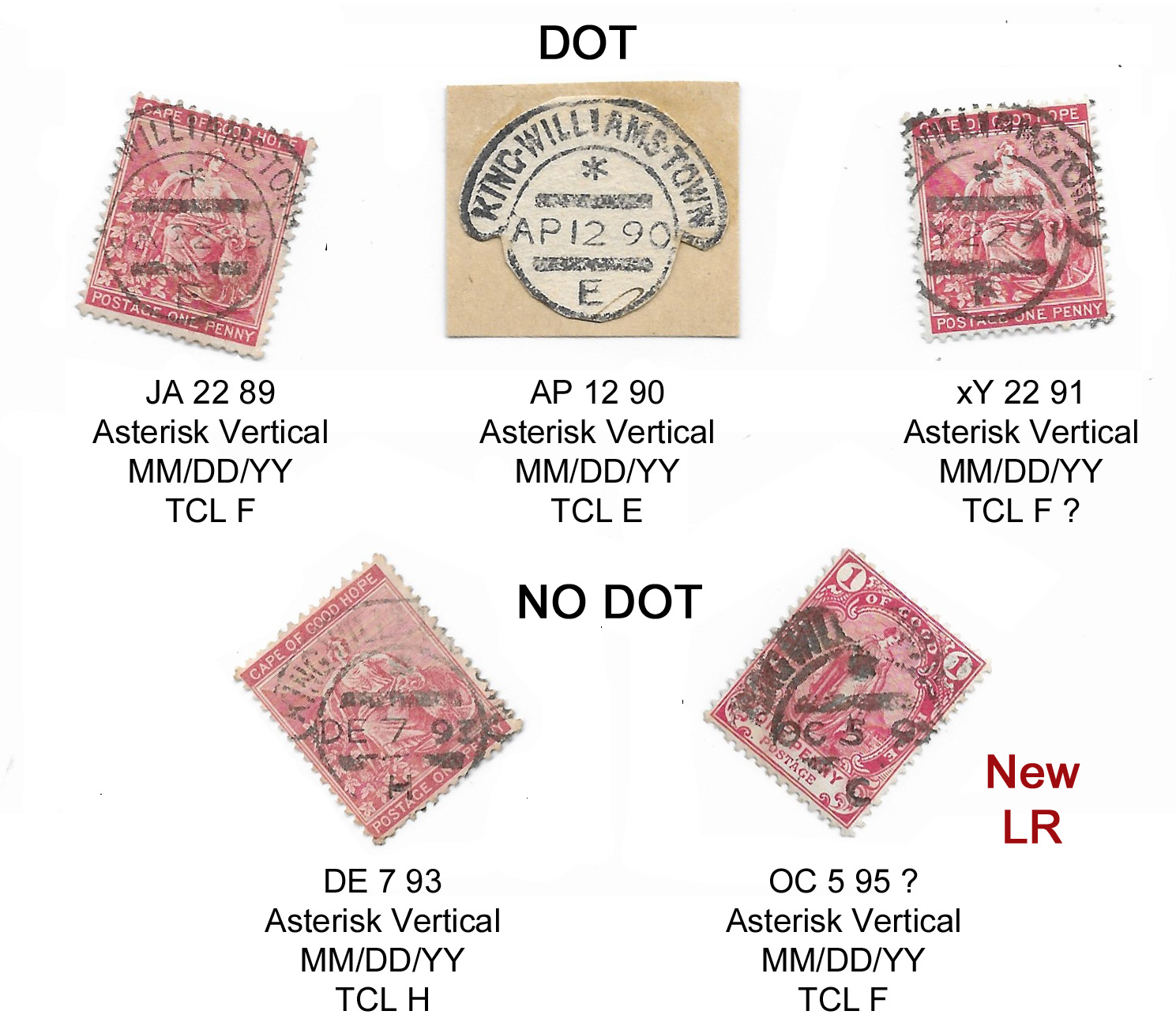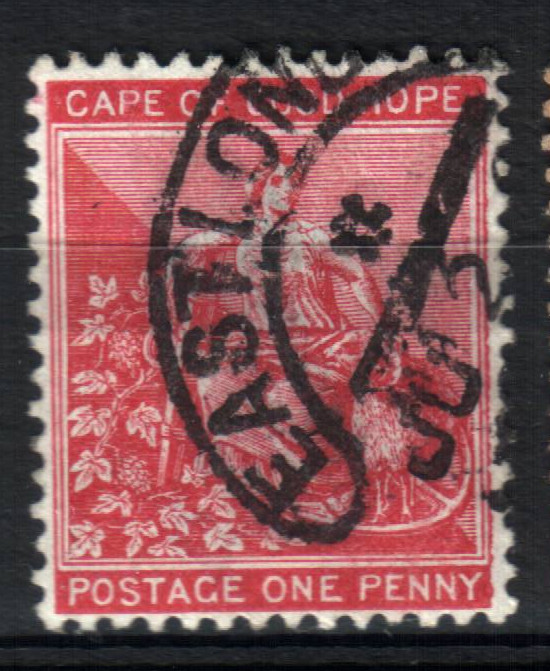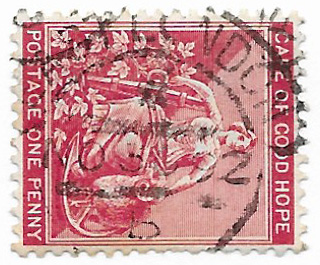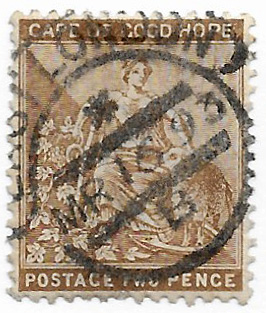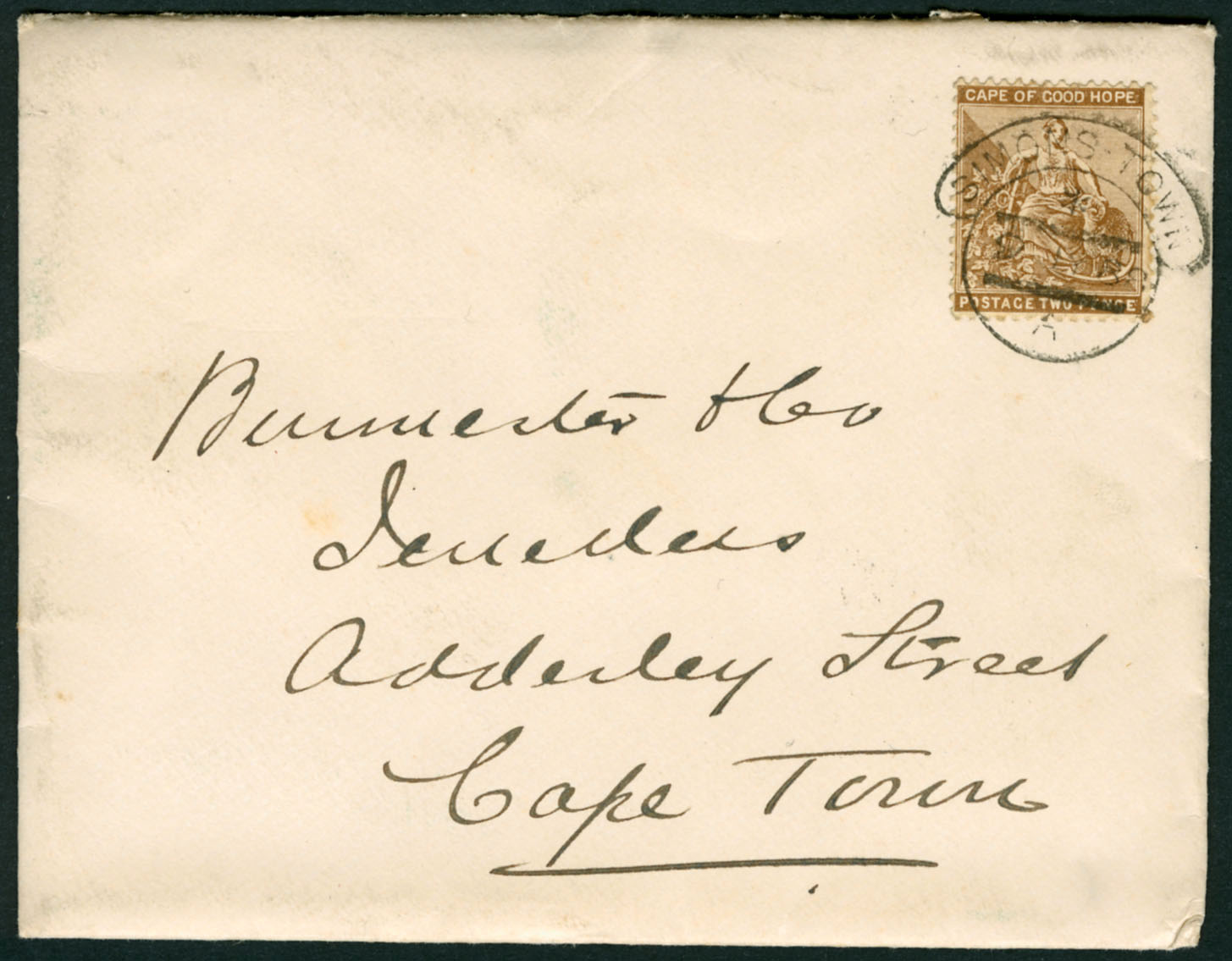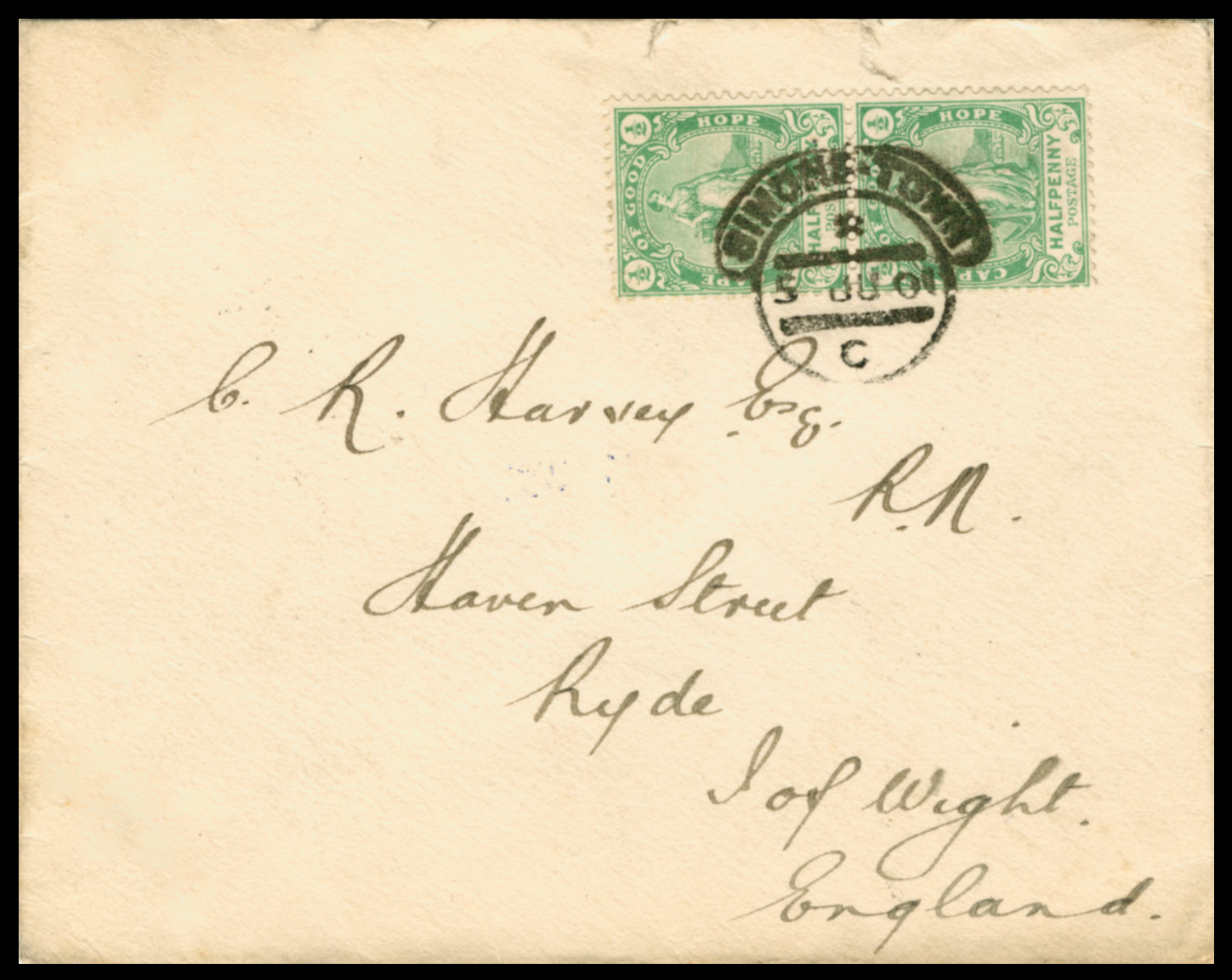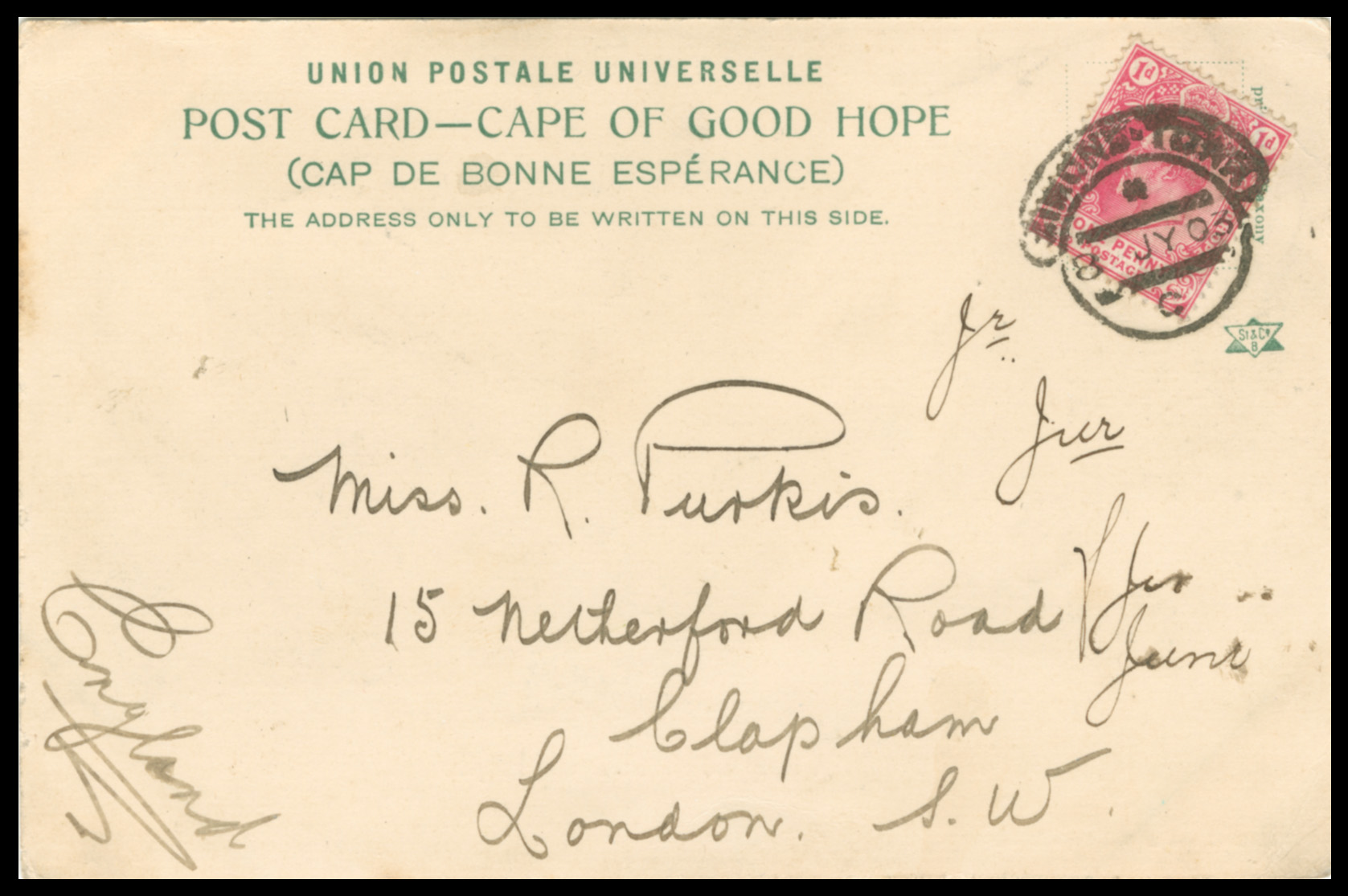The Hooded Datestamps of Southern Africa 1888 - 1903
Quote from Steve on July 21, 2023, 9:39 amAs ever, many thanks for your advice and input. Glad this thread is bearing a little fruit.
I note that all your Perkins HCD covers above are from 1889 or 1890. Your '28th October 1899' date should be 1889. As the SAW was still ten years in the future, your covers went via the normal pre-war Cape Colonial postal system.
I also note that the Date format for all your covers is DD/MM/YY with Asterisk top, Time Code letter below. This confirms what I have found among my Kimberley examples.
My limited data accumulation suggests the Kimberley HCD becomes scarcer after 1890. Your posted examples are from the same period as mine, the less scarce period. If you do not have any Kimberley HCDs after 1890, the absence of these will tend to support my observation that we possibly have a mysterious gap between end-1890 and '27 MR 1900', (Frescura's date for his oldest LR from Kimberley). Assuming the Kimberley HCD was discontinued in 1890, could Frescura's '1900' be a typo that should read 1890? The nagging thing about this assumption is that 28th October 1890 is still very early in the active life of the HCD as recorded postally used elsewhere in the Cape.
All this could be quickly resolved by someone posting KIMBERLEY HCDs from the mid-90s. (If such exist!)
As ever, many thanks for your advice and input. Glad this thread is bearing a little fruit.
I note that all your Perkins HCD covers above are from 1889 or 1890. Your '28th October 1899' date should be 1889. As the SAW was still ten years in the future, your covers went via the normal pre-war Cape Colonial postal system.
I also note that the Date format for all your covers is DD/MM/YY with Asterisk top, Time Code letter below. This confirms what I have found among my Kimberley examples.
My limited data accumulation suggests the Kimberley HCD becomes scarcer after 1890. Your posted examples are from the same period as mine, the less scarce period. If you do not have any Kimberley HCDs after 1890, the absence of these will tend to support my observation that we possibly have a mysterious gap between end-1890 and '27 MR 1900', (Frescura's date for his oldest LR from Kimberley). Assuming the Kimberley HCD was discontinued in 1890, could Frescura's '1900' be a typo that should read 1890? The nagging thing about this assumption is that 28th October 1890 is still very early in the active life of the HCD as recorded postally used elsewhere in the Cape.
All this could be quickly resolved by someone posting KIMBERLEY HCDs from the mid-90s. (If such exist!)
Quote from yannisl on July 21, 2023, 10:58 amHi Steve
I think Frescura made a typo like I did! I also searched what I have after that date and is mostly using single circle cds. One would never be sure though. I got my dates wrong all over 🙂 thanks for sorting this one out.
Hi Steve
I think Frescura made a typo like I did! I also searched what I have after that date and is mostly using single circle cds. One would never be sure though. I got my dates wrong all over 🙂 thanks for sorting this one out.
Quote from Steve on July 22, 2023, 4:30 pmKING WILLIAMS TOWN
There are two KWT HCDs. The difference between them lies in the first issue's smaller type size used in the Hood and the hyphen and dot that separates the town name. The HCD is often difficult to categorise because the long town name reduces space between words and letters, making it hard to see the distinguishing features of its hyphen and or dot, especially when the datestamp is dirty or over-inked. Generally, the quality of the examples we have are poor. We need more examples from King Williams Town, please.
Frescura provides a useful starting point. His work reveals a belief that there are two KING WILLIAMS TOWN HCDs. The dates he gives for his ERs and LRs suggest that the second HCD replaced the first and that they were NOT used concurrently. Experienced postal historians will be wary of such interpretations. If the statement were true, we could simply arrange our examples in date order to determine which HCD they are. But sadly, it is not true. Even so, it suggests that a murky HCD in the timeframe 1888 - 1891 with a hyphen or dot is more likely to be the earliest issue rather than the later one with no hyphen or dot(s) and taller typerface.
- There are two HCDs. Putzel records one, Frescura two. There may be a third variety.
- Frescura provides ERs and LRs for both. We have a new LR for the first issue.
- In both HCD issues, the Asterisk is in the top segment. We have seen no exceptions.
- The Asterisk is invariably Vertical. We have seen just one debatable Horizontal example.
- The Date format is always seen as MM/DD/YY. There are no exceptions.
- The Time Code letter is in the bottom segment. We have seen no exceptions.
- We have seen no visible Blanks in place of a Time Code letter.
- These two HCD remained remarkably uniform throughout eight years of postal use.
KING WILLIAMS TOWN
There are two KWT HCDs. The difference between them lies in the first issue's smaller type size used in the Hood and the hyphen and dot that separates the town name. The HCD is often difficult to categorise because the long town name reduces space between words and letters, making it hard to see the distinguishing features of its hyphen and or dot, especially when the datestamp is dirty or over-inked. Generally, the quality of the examples we have are poor. We need more examples from King Williams Town, please.
Frescura provides a useful starting point. His work reveals a belief that there are two KING WILLIAMS TOWN HCDs. The dates he gives for his ERs and LRs suggest that the second HCD replaced the first and that they were NOT used concurrently. Experienced postal historians will be wary of such interpretations. If the statement were true, we could simply arrange our examples in date order to determine which HCD they are. But sadly, it is not true. Even so, it suggests that a murky HCD in the timeframe 1888 - 1891 with a hyphen or dot is more likely to be the earliest issue rather than the later one with no hyphen or dot(s) and taller typerface.
- There are two HCDs. Putzel records one, Frescura two. There may be a third variety.
- Frescura provides ERs and LRs for both. We have a new LR for the first issue.
- In both HCD issues, the Asterisk is in the top segment. We have seen no exceptions.
- The Asterisk is invariably Vertical. We have seen just one debatable Horizontal example.
- The Date format is always seen as MM/DD/YY. There are no exceptions.
- The Time Code letter is in the bottom segment. We have seen no exceptions.
- We have seen no visible Blanks in place of a Time Code letter.
- These two HCD remained remarkably uniform throughout eight years of postal use.
Quote from Steve on July 23, 2023, 12:41 pmBack to the Drawing Board....
I have been in contact with Alex Visser who maintains the Postmark on-line Addendum to his and Putzel's work. I like to report new finds to him so that they become centrally archived in a resource accessible to all postal historians. I recommend to all who collect postmarks that when you find something that is not in Putzel or Alex's Addendum, (available on the PFSA website), you submit your finds to him.
Alex is finding our work here a 'very interesting exploration'. That's encouraging to know. He is the pre-eminent South African postmark fundi. Prof. Phundi Visser RDPSA, nogal!
KIMBERLEY
Alex writes: "I have 11 items in my Kimberley collection.
ER 27 FE 89; LR 19 MY 90
Time code letters A, C, D, H and all with star above.
I agree with the likelihood of a misread 1900 date."It is good to know that Alex thinks that the typo (Franco's Kimberley '1900 ' date) is 'a likelihood'. We now need to prove this a fact. The only way to do so is to disprove the existence of Kimberley HCDs after late 1890. This requires us to keep looking for examples in the hope of not finding any. When does that stop?
He asks "What is the latest date that you have recorded?"
The latest date we have recorded is Simon Kelly's KIMBERLEY '3 JU 90'.
After posting the Kimberley section Yannis emailed us an example of KIMBERLEY '2 JU 90' on cover. If and when the typo of 1900 is confirmed a fact, Yannis will have the second latest example of the KIMBERLEY LR (Latest Recorded) after Simon Kelly, assuming, of course, that we do not find later examples in the meantime. Hard luck, Yannis. Keep trying, you never know! This is a funny old game. Probably more where that came from!
KING WILLIAMS TOWN
Alex writes: "Dr Kelly 17 OC 92 supersedes my LR. This means that the two HC were used concurrently." It also means that it is the new KWT with Dots, shorter typeface LR.
Regarding the KWT No Dots, taller typeface, Alex now records an LR of 'OC 5 95'. You can see it among his supplied examples below. If he is confident that the last Year numeral is a '5', that is good enough for me but I would still wish it was clearer, just to be totally sure.
It is good to see these examples from Alex because they confirm our exploration's tentative findings - that in the KWT HDCs the Asterisk is always top and vertical, the Date format is always MM/DD/YY and the Time Code letter is always below. Good result! Thank you! Now, please provide examples to burst this cosy well-ordered bubble!
Back to the Drawing Board....
I have been in contact with Alex Visser who maintains the Postmark on-line Addendum to his and Putzel's work. I like to report new finds to him so that they become centrally archived in a resource accessible to all postal historians. I recommend to all who collect postmarks that when you find something that is not in Putzel or Alex's Addendum, (available on the PFSA website), you submit your finds to him.
Alex is finding our work here a 'very interesting exploration'. That's encouraging to know. He is the pre-eminent South African postmark fundi. Prof. Phundi Visser RDPSA, nogal!
KIMBERLEY
Alex writes: "I have 11 items in my Kimberley collection.
ER 27 FE 89; LR 19 MY 90
Time code letters A, C, D, H and all with star above.
I agree with the likelihood of a misread 1900 date."
It is good to know that Alex thinks that the typo (Franco's Kimberley '1900 ' date) is 'a likelihood'. We now need to prove this a fact. The only way to do so is to disprove the existence of Kimberley HCDs after late 1890. This requires us to keep looking for examples in the hope of not finding any. When does that stop?
He asks "What is the latest date that you have recorded?"
The latest date we have recorded is Simon Kelly's KIMBERLEY '3 JU 90'.
After posting the Kimberley section Yannis emailed us an example of KIMBERLEY '2 JU 90' on cover. If and when the typo of 1900 is confirmed a fact, Yannis will have the second latest example of the KIMBERLEY LR (Latest Recorded) after Simon Kelly, assuming, of course, that we do not find later examples in the meantime. Hard luck, Yannis. Keep trying, you never know! This is a funny old game. Probably more where that came from!
KING WILLIAMS TOWN
Alex writes: "Dr Kelly 17 OC 92 supersedes my LR. This means that the two HC were used concurrently." It also means that it is the new KWT with Dots, shorter typeface LR.
Regarding the KWT No Dots, taller typeface, Alex now records an LR of 'OC 5 95'. You can see it among his supplied examples below. If he is confident that the last Year numeral is a '5', that is good enough for me but I would still wish it was clearer, just to be totally sure.
It is good to see these examples from Alex because they confirm our exploration's tentative findings - that in the KWT HDCs the Asterisk is always top and vertical, the Date format is always MM/DD/YY and the Time Code letter is always below. Good result! Thank you! Now, please provide examples to burst this cosy well-ordered bubble!
Uploaded files:Quote from yannisl on July 23, 2023, 1:56 pmKimberley
I always thought that you cannot prove a negative! However, if a later example shows up, our theory of a type will be wrong and we have to revise.
King Williams Town
I don't have any covers for King Williams Town.
Kimberley
I always thought that you cannot prove a negative! However, if a later example shows up, our theory of a type will be wrong and we have to revise.
King Williams Town
I don't have any covers for King Williams Town.
Quote from Steve on July 29, 2023, 6:47 pmPORT ELZABETH
There are two main PE HCDs, the first issued in 1888 to 1890 with a 'dot separator' as described by Frescura and another without a dot which, based on the limited examples I have, appears to have been used between 1895 to 1896. This suggests a remarkable five year gap when the HCD was not being used in PE. Hopefully someone will send some examples to help disprove my finding.
We are fortunate to have Yannis Lazarides wonderful PE ER to illustrate the early section with HCD (Dot). Frescura's PE ER is this cover. It is the only example of an HCD (Dot) with Blank bottom segment that we have. All other HCD (Dot) examples we have are consistent in their format - Asterisk top, Date as DD/MM/YY and a Time Code letter in the bottom segment.
Frescura's LR of 'xx xx 1898' is problematic as he gives it for his HCD with 'dot separator'. This cannot be if the HCD (Dot) was discontinued in 1890 as our research suggests. Frescura can only be describing the PE HCD (No Dot) that he does not list. This later HCD (No Dot) uses no Asterisk. It has a Time Code letter top, Date as DD/MM/YY and is Blank at base. This different format also appears to be quite consistent.
In summary:
- There are two HCDs, one with a dot separtor, the other without.
- Jurgens and Goldblatt show no examples of PE HCDs.
- Putzel records one but makes no reference to a dot. He lists three varieties.
- Frescura list one HCD with dot separator. The HCD (No Dot) lies buried within it.
- The HCD (DOT) has an Asterisk in the top segment.
- The Date is DD/MM/YY. No exceptions have been found.
- The Time Code letter is in the bottom segment.
- The HCD (No Dot) is remarkable for the absence of an Asterisk.
- The Time Code letter is in the top segment.
- The Date is DD/MM/YY. There is one exception.
- The bottom segment is Blank.
- Frescura provides ERs and LRs for the HCD (Dot).
- Frescura's LR must be for the later HCD (No Dot).
- The format of these two HCD remained remarkably consistent throughout their use.
PORT ELZABETH
There are two main PE HCDs, the first issued in 1888 to 1890 with a 'dot separator' as described by Frescura and another without a dot which, based on the limited examples I have, appears to have been used between 1895 to 1896. This suggests a remarkable five year gap when the HCD was not being used in PE. Hopefully someone will send some examples to help disprove my finding.
We are fortunate to have Yannis Lazarides wonderful PE ER to illustrate the early section with HCD (Dot). Frescura's PE ER is this cover. It is the only example of an HCD (Dot) with Blank bottom segment that we have. All other HCD (Dot) examples we have are consistent in their format - Asterisk top, Date as DD/MM/YY and a Time Code letter in the bottom segment.
Frescura's LR of 'xx xx 1898' is problematic as he gives it for his HCD with 'dot separator'. This cannot be if the HCD (Dot) was discontinued in 1890 as our research suggests. Frescura can only be describing the PE HCD (No Dot) that he does not list. This later HCD (No Dot) uses no Asterisk. It has a Time Code letter top, Date as DD/MM/YY and is Blank at base. This different format also appears to be quite consistent.
In summary:
- There are two HCDs, one with a dot separtor, the other without.
- Jurgens and Goldblatt show no examples of PE HCDs.
- Putzel records one but makes no reference to a dot. He lists three varieties.
- Frescura list one HCD with dot separator. The HCD (No Dot) lies buried within it.
- The HCD (DOT) has an Asterisk in the top segment.
- The Date is DD/MM/YY. No exceptions have been found.
- The Time Code letter is in the bottom segment.
- The HCD (No Dot) is remarkable for the absence of an Asterisk.
- The Time Code letter is in the top segment.
- The Date is DD/MM/YY. There is one exception.
- The bottom segment is Blank.
- Frescura provides ERs and LRs for the HCD (Dot).
- Frescura's LR must be for the later HCD (No Dot).
- The format of these two HCD remained remarkably consistent throughout their use.
Quote from Steve on July 30, 2023, 1:31 pmQUEENS TOWN
I thought that Queens Town would be quickly done as we have only one cover and one stamp. However, we have a surprising number of drawings from 'experts'. Some of these examples draw on a common source, A. A. Jurgens RDPSA FRPSL. Putzel listed Jurgens' example as does Frescura who based his 'HC with dot separator' on it, thereby consigning all examples of the HCD (No Dot) to the netherworld, neither recognised nor listed.
Goldblatt provides two hand-drawn examples that suggest the existence of a QUEENS TOWN HCD (No Dot). Given the early 1889 dates on Goldblatt's examples, I believe that the artist neglected to include the dot (or that it was lost). In other towns with a HCD (No Dot) these appear later than Goldblatt's examples of 1889. Indeed, Kelly also shows a drawing of an 1888 QUEENS TOWN HCD (No Dot). Fortunately, however, we can see his error of omission, the dot, on his supplied cover. The remaining expert. Alex Visser, records no new Queens Town HCDs. This field is surprisingly empty of proper examples.
I am willing to believe that a QUEENS TOWN HCD (No Dot) of later date, (post 1890. perhaps), may possibly exist as this is the pattern we have seen in other towns that were issued with a HCD (No Dot). But right now, we have NO example of it. Kelly's drawing was wrong and so, I suspect, is Goldblatt's. This is a difficult thing for me to conclude as his book has for many years been my favourite Cape resource and reference guide. While the solution to this is to find more examples of both types, finding and proving a QUEENS TOWN HCD (No Dot) would be great.
In summary:
- We record only one HCD. This has a dot separator.
- Jurgens (1 example), Frescura (1), Goldblatt (2) and Putzel (1) list examples
- Frescura HC with dot separator holds the HCD (No Dot) buried within it.
- A Time Code letter or a Blank appears is in the top segment.
- The Date is MM/DD/ YY. No exceptions have been found.
- An Asterisk is in the bottom segment.
- Frescura provides ERs and LRs for his HC (Dot).
QUEENS TOWN
I thought that Queens Town would be quickly done as we have only one cover and one stamp. However, we have a surprising number of drawings from 'experts'. Some of these examples draw on a common source, A. A. Jurgens RDPSA FRPSL. Putzel listed Jurgens' example as does Frescura who based his 'HC with dot separator' on it, thereby consigning all examples of the HCD (No Dot) to the netherworld, neither recognised nor listed.
Goldblatt provides two hand-drawn examples that suggest the existence of a QUEENS TOWN HCD (No Dot). Given the early 1889 dates on Goldblatt's examples, I believe that the artist neglected to include the dot (or that it was lost). In other towns with a HCD (No Dot) these appear later than Goldblatt's examples of 1889. Indeed, Kelly also shows a drawing of an 1888 QUEENS TOWN HCD (No Dot). Fortunately, however, we can see his error of omission, the dot, on his supplied cover. The remaining expert. Alex Visser, records no new Queens Town HCDs. This field is surprisingly empty of proper examples.
I am willing to believe that a QUEENS TOWN HCD (No Dot) of later date, (post 1890. perhaps), may possibly exist as this is the pattern we have seen in other towns that were issued with a HCD (No Dot). But right now, we have NO example of it. Kelly's drawing was wrong and so, I suspect, is Goldblatt's. This is a difficult thing for me to conclude as his book has for many years been my favourite Cape resource and reference guide. While the solution to this is to find more examples of both types, finding and proving a QUEENS TOWN HCD (No Dot) would be great.
In summary:
- We record only one HCD. This has a dot separator.
- Jurgens (1 example), Frescura (1), Goldblatt (2) and Putzel (1) list examples
- Frescura HC with dot separator holds the HCD (No Dot) buried within it.
- A Time Code letter or a Blank appears is in the top segment.
- The Date is MM/DD/ YY. No exceptions have been found.
- An Asterisk is in the bottom segment.
- Frescura provides ERs and LRs for his HC (Dot).
Quote from Steve on August 1, 2023, 7:39 amI have written an article reviewing the SACS Zoom meeting of Saturday 13th May, 2023 in which Tony Johnson, editor of the Springbok, presented Dr Simon Kelly's "The Hooded Postmarks of Southern Africa". My article, which has now appeared in the 'Springbok', (363), covers the Zoom display and ensuing from it this discussion and study of the HCD. It is a tribute to Simon's inspiring display and Tony's effort to show it that we are now attempting to broaden our understanding of this neglected and much misunderstood datestamp here. Few Zoom displays achieve such impact!
Barry Knox's surprising contribution
As a result of the Springbok being emailed (£12 pa) and or posted to SACS members (£18 pa) I have been contacted by Barry Knox who wrote "Spotted the hooded article and remembered the attached for what it's worth. BUT I doubt this scruffy lady's of much interest!" The heavy postmark is an incomplete EAST LONDON (No Dot) of indeterminate date. The Asterisk is vertical and the date is in the format MM/DD/YY. There is nothing visible below the bottom bar. (There is a clue in there!) The stamps appears to be in good condition, undamaged and well-centred, a 6/10 to stamp collectors. It is a certainly not scruffy. It's a nice used example of the common Cape 1d red stamp of 1884.
We are always grateful for contributions but sadly, as Barry implies, his stamp is of little help here because the Year in the Date is missing. Had there there been a Year included in the postmark, I would have used it. Without a Year it has no context. However, it is useful in as much as it shows to some large extent what we cannot use in our research. For that reason, I include it here. Thank you, Barry.
PS: The lady is no scruff. But, perhaps like many of us from the South African diaspora, Hope is now a tramp.
Postscript following further advice from Barry .....
Barry has emailed me back. He has drawn my less than eagle-eyed attention to the fact that I TOTALLY MISSED making the observation that the BOTTOM ARC that completes the 'CIRCLE in his HCD is MISSING. How much is missing is moot. The circle appears to pick up again below the 'J' against the perforations. There's not enough to be certain. IMO, it's a large gap, not a missing arc.,Talk about not seeing the WOODS for the TREES! This is QUITE REMARKABLE eacmple. Can anyone offer any advice on this. We know that in some HCDs the circle is broken at the point that appears missing but NOT to this extent. Wow. What an anomaly! Are there other examples I've missed? I've just had a look and there are four East London HCDs that appear to show this also.
1]. Barry's example with 'missing circle', below.
These four can be seen in the East London PDF.
2]. An EL (No Dot) of NO 30 92.
3]. An EL (No Dot) of MR 16 93.
4]. An EL (No Dot) of JY xx 93. (This is Putzel's example).
5]. And best of all, an EL (No Dot) of JY 23 94.
I have written an article reviewing the SACS Zoom meeting of Saturday 13th May, 2023 in which Tony Johnson, editor of the Springbok, presented Dr Simon Kelly's "The Hooded Postmarks of Southern Africa". My article, which has now appeared in the 'Springbok', (363), covers the Zoom display and ensuing from it this discussion and study of the HCD. It is a tribute to Simon's inspiring display and Tony's effort to show it that we are now attempting to broaden our understanding of this neglected and much misunderstood datestamp here. Few Zoom displays achieve such impact!
Barry Knox's surprising contribution
As a result of the Springbok being emailed (£12 pa) and or posted to SACS members (£18 pa) I have been contacted by Barry Knox who wrote "Spotted the hooded article and remembered the attached for what it's worth. BUT I doubt this scruffy lady's of much interest!" The heavy postmark is an incomplete EAST LONDON (No Dot) of indeterminate date. The Asterisk is vertical and the date is in the format MM/DD/YY. There is nothing visible below the bottom bar. (There is a clue in there!) The stamps appears to be in good condition, undamaged and well-centred, a 6/10 to stamp collectors. It is a certainly not scruffy. It's a nice used example of the common Cape 1d red stamp of 1884.
We are always grateful for contributions but sadly, as Barry implies, his stamp is of little help here because the Year in the Date is missing. Had there there been a Year included in the postmark, I would have used it. Without a Year it has no context. However, it is useful in as much as it shows to some large extent what we cannot use in our research. For that reason, I include it here. Thank you, Barry.
PS: The lady is no scruff. But, perhaps like many of us from the South African diaspora, Hope is now a tramp.
Postscript following further advice from Barry .....
Barry has emailed me back. He has drawn my less than eagle-eyed attention to the fact that I TOTALLY MISSED making the observation that the BOTTOM ARC that completes the 'CIRCLE in his HCD is MISSING. How much is missing is moot. The circle appears to pick up again below the 'J' against the perforations. There's not enough to be certain. IMO, it's a large gap, not a missing arc.,
Talk about not seeing the WOODS for the TREES! This is QUITE REMARKABLE eacmple. Can anyone offer any advice on this. We know that in some HCDs the circle is broken at the point that appears missing but NOT to this extent. Wow. What an anomaly! Are there other examples I've missed? I've just had a look and there are four East London HCDs that appear to show this also.
1]. Barry's example with 'missing circle', below.
These four can be seen in the East London PDF.
2]. An EL (No Dot) of NO 30 92.
3]. An EL (No Dot) of MR 16 93.
4]. An EL (No Dot) of JY xx 93. (This is Putzel's example).
5]. And best of all, an EL (No Dot) of JY 23 94.
Quote from Steve on August 1, 2023, 11:03 amSIMONS TOWN
This is the last town in our HCD review but probably one of the first to have received the HCD. As the post office serving the Royal Navy base, Simons-Town punched above its weight and commanded some deference from the central Cape Post Office in Cape Town. The HCD is believed to have been unpopular with most of the offices which received it, however, Simon-Town used it longest of all from 1888 - 1903.
Frescura lists the ER and LR for 'HC SIMONS-TOWN' as '11 JA 1889' and '10 DE 1902'.
We can revise that completely. See the covers below. The first (top) is dated '9 JY 88' and the last '8 JY 03'. This ER has been recorded by Alex Visser whose previous ER was our second cover shown of '26 SP 88'. Our LR (bottom postcard) awaits approval. Note its 'block' separating SIMONS and TOWN. Typically this is a thin hypen. By this late stage (1902 - 1903) it is seen as a 'block'. I have other examples. Is this is a new HCD or just a symptom of long use?
We are fortunate again to have had Alex Visser send in six examples of the SIMONS-TOWN HCD. He says "Of interest is that all the items on my scan have a dot, or dirty dot. ER 5 AU 89 to 11 SP 91, then a gap 3 FE 00 to LR 28 JY 00." In another email Alex again refers to a gap in the use of the HCD in Simons Town during the 1890s. Among my examples is one from '27 FE 95'. As a 'Simons Town' collector I have amassed a good range of its HCDs, some of which are shown below. I look forward to presenting them here. However ....
I am going to take my time with posting the Simons-Town section, maybe a week or so. I have a philatelic society 'Show what you like' display to give tomorrow night that I need to work on. Also, today my time is taken up with festivities. Today is Switzerland's birthday (1st August 1291). Co-incidentally, it is also Yorkshire Day. (My Dad was a Yorkshireman, as is my brother-in-law.) Our family is celebrating tonight with flags and a cheese fondue - en Guetä. ('Bon appetit' in Swiss German..... I think!) I shall wear lederhosen and sing like a cuckoo clock. Only joking! Neither are Swiss. Both are German. Its a confusion that drives my proudly Swiss mother-in-law mad.
SIMONS TOWN
This is the last town in our HCD review but probably one of the first to have received the HCD. As the post office serving the Royal Navy base, Simons-Town punched above its weight and commanded some deference from the central Cape Post Office in Cape Town. The HCD is believed to have been unpopular with most of the offices which received it, however, Simon-Town used it longest of all from 1888 - 1903.
Frescura lists the ER and LR for 'HC SIMONS-TOWN' as '11 JA 1889' and '10 DE 1902'.
We can revise that completely. See the covers below. The first (top) is dated '9 JY 88' and the last '8 JY 03'. This ER has been recorded by Alex Visser whose previous ER was our second cover shown of '26 SP 88'. Our LR (bottom postcard) awaits approval. Note its 'block' separating SIMONS and TOWN. Typically this is a thin hypen. By this late stage (1902 - 1903) it is seen as a 'block'. I have other examples. Is this is a new HCD or just a symptom of long use?
We are fortunate again to have had Alex Visser send in six examples of the SIMONS-TOWN HCD. He says "Of interest is that all the items on my scan have a dot, or dirty dot. ER 5 AU 89 to 11 SP 91, then a gap 3 FE 00 to LR 28 JY 00." In another email Alex again refers to a gap in the use of the HCD in Simons Town during the 1890s. Among my examples is one from '27 FE 95'. As a 'Simons Town' collector I have amassed a good range of its HCDs, some of which are shown below. I look forward to presenting them here. However ....
I am going to take my time with posting the Simons-Town section, maybe a week or so. I have a philatelic society 'Show what you like' display to give tomorrow night that I need to work on. Also, today my time is taken up with festivities. Today is Switzerland's birthday (1st August 1291). Co-incidentally, it is also Yorkshire Day. (My Dad was a Yorkshireman, as is my brother-in-law.) Our family is celebrating tonight with flags and a cheese fondue - en Guetä. ('Bon appetit' in Swiss German..... I think!) I shall wear lederhosen and sing like a cuckoo clock. Only joking! Neither are Swiss. Both are German. Its a confusion that drives my proudly Swiss mother-in-law mad.
Uploaded files:Quote from Steve on August 9, 2023, 8:14 amPhew! This seems to have taken too long at a time when I desperately need to get a 180 page display together on Simons Town for the Cambridge Philatelic Society meeting next month (6th September 2023). Then, in the midst of my anxiety, it suddenly dawned on me that all the work I was doing here was not at all a divisive waste of time because I could include it in my bigger Simons Town diplay and at the same time take the opportunity to pay tribute to Simon Kelly, Past President of the CPS. With that revelation, everything seemed to fall into place. A Sisyphean weight was lifted and I felt like the Olympian Gods of Philately were shining down on me from dizzy marbled heights. I love it when a plan comes unexpectedly together as a mix of hard work and magic. Thank you, Simon.
While the HCD is believed to have been unpopular with most of the post offices which used it, Simon Town persisted with it longest of all, from at least June 1888 to July 1903. Frescura lists the ER and LR for 'HC SIMONS-TOWN' as '11 JA 1889' and '10 DE 1902'. Our research has revised these dates completely with new ERs and an LR. My thanks to everyone who submitted material. This is the most comprehensive set of examples we have yet worked with. The only Year missing an example is 1893. Previously it was thought that there might be gap in the HCD's use between 1893 and 1895 but with examples for 1894 and 1895 included this is now largely disproven.
In summary:
- We record only one HCD. This has a hyphen separator.
- The Simons Town HCD is remarkably consistent, only the Asterisk changing!
- The Asterisk only ever appears in the Top segment.
- We have seen NO Blank Top segments.
- The Date is DD/MM/YY. No exceptions have been found.
- A Time Code letter always appears in the Bottom segment.
- We have seen NO Blank Bottom segments.
Phew! This seems to have taken too long at a time when I desperately need to get a 180 page display together on Simons Town for the Cambridge Philatelic Society meeting next month (6th September 2023). Then, in the midst of my anxiety, it suddenly dawned on me that all the work I was doing here was not at all a divisive waste of time because I could include it in my bigger Simons Town diplay and at the same time take the opportunity to pay tribute to Simon Kelly, Past President of the CPS. With that revelation, everything seemed to fall into place. A Sisyphean weight was lifted and I felt like the Olympian Gods of Philately were shining down on me from dizzy marbled heights. I love it when a plan comes unexpectedly together as a mix of hard work and magic. Thank you, Simon.
While the HCD is believed to have been unpopular with most of the post offices which used it, Simon Town persisted with it longest of all, from at least June 1888 to July 1903. Frescura lists the ER and LR for 'HC SIMONS-TOWN' as '11 JA 1889' and '10 DE 1902'. Our research has revised these dates completely with new ERs and an LR. My thanks to everyone who submitted material. This is the most comprehensive set of examples we have yet worked with. The only Year missing an example is 1893. Previously it was thought that there might be gap in the HCD's use between 1893 and 1895 but with examples for 1894 and 1895 included this is now largely disproven.
In summary:
- We record only one HCD. This has a hyphen separator.
- The Simons Town HCD is remarkably consistent, only the Asterisk changing!
- The Asterisk only ever appears in the Top segment.
- We have seen NO Blank Top segments.
- The Date is DD/MM/YY. No exceptions have been found.
- A Time Code letter always appears in the Bottom segment.
- We have seen NO Blank Bottom segments.

